A Stocktaking of the Acquisition of Personal Papers
T
T
The personal papers of some 320 Scientific Members of the Max Planck Society and other important personalities in the field of history of science are meanwhile being stored at the Archives of the Max Planck Society. In the past two and a half years, the Archives’ Department III could be extended to include quite a number of additional personal papers. Thus, there were a total of 23 new acquisitions and nine major subsequent deliveries related to existing archival collections between January 2015 and July 2017. In addition, it has been possible to make a variety of personal papers, which were partly very extensive (and included papers taken over in earlier times), accessible.
In total, there have been some 120 running metres of acquisitions and 95 running metres of new descriptions between 2015 and 2017.
Acquisitions that are more recent comprise the personal papers of the following scientists, among others:
-
Leo De Maeyer (Max Planck Institute for Biophysical Chemistry),
-
Ulrich Drobnig (Max Planck Institute for Foreign and International Private Law),
-
Wilhelm Feuerlein (Max Planck Institute of Psychiatry - German Institute for Psychiatric Research),
-
Peter Gruss (Max Planck Institute for Biophysical Chemistry),
-
Ernst Rabel (Kaiser Wilhelm Institute for Foreign and International Private Law)
-
Joachim E. Trümper (Max Planck Institute for Extraterrestrial Physics)
-
Matthias Winner (Bibliotheca Hertziana)
-
Wolfhart Zimmermann (Max Planck Institute for Physics and Astrophysics)
Furthermore, the acquisition of the personal papers of eight scientists (five new acquisitions and three subsequent deliveries) from the fields of physics and peace research, developmental biology, biogeochemistry, cognition sciences, criminal law and international law will be forthcoming any time soon.
Major and more complex/important descriptions that could recently be completed refer to the collections of personal papers of the following scientists, among others:
-
Peter Berthold (20 r.m.)
-
Leo De Maeyer (2 r.m.)
-
Norbert Hilschmann (2 r.m.)
-
Reinhold von Sengbusch (3 r.m.)
-
Werner Heisenberg (28 r.m.)
-
Ernst Rüdin (1 r.m.)
-
Carl Friedrich von Weizsäcker (32 r.m.)
-
Matthias Winner (4 r.m.)
-
Hans F. Zacher (30 r.m.)
In the context of the newly acquired personal papers, depository or donation agreements were concluded, settling not only the property issue but also particularly the use of the documents by historic research. Owing to the protection periods provided under archival law and to individual contractual stipulations, it has so far not been possible to make all personal papers accessible without limitations.
Merely a few collections, which have already been made accessible to research, are identified in detail here:
The finding aids for these and other collections are available
under our new Online Overview of Collections
Joachim-Dieter Bloch (AMPG, III. Abt., Rep. 124)
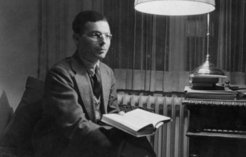
(AMPG Abt., VI, Rep. 1, KWI for Foreign Public Law and International Law No. III/45)
Joachim-Dieter Bloch (1906-1945) was a German lawyer who, although deemed a “one-quarter Jew”, continued to be employed as an advisor at the Kaiser Wilhelm Institute for Foreign Public Law and International Law after 1933. He was closely related to resistance to Hitler and was tragically shot by a member of the Red Army in the last days of the war in 1945.
His personal papers had been enriched (already at the location of their depositor) by documents of his parents, Walther Bloch and Else Bloch-Wunschmann, and by his spouse Rosemarie Bloch. They mainly consist of correspondence and manuscripts. In a few documents, he also provides information about life at the Institute. The personal papers of Joachim-Dieter Bloch’s father, bookseller and publisher Walther Bloch, are stored at the German Literary Archive Marbach.

(AMPG, Abt., VI, Rep. 1 KWI for Foreign Public Law and International Law no. III/46)
Size: The collection extends over 0.7 running metres; the overall duration covers the years from approx. 1890 until 1965.
Literature: Max Bloch, Dr. Joachim-Dieter Bloch (1906-1945). Ein Juristenleben am Kaiser-Wilhelm-Institut für ausländisches öffentliches Recht und Völkerrecht [A lawyer’s life at the Kaiser Wilhelm Institute for Foreign Public Law and International Law], in: ZaöRV 74 (2014), pages 1-6.
Related collections: Department I, Rep. 47, KWI for Foreign Public Law and International Law; Department III, Rep. 44, Carl Bilfinger; Department III, Rep. 95, Alexander N. Makarov; Department III, ZA 139, Hermann Mosler
Johannes Heydenreich (AMPG, III. Abt., Rep. 123)
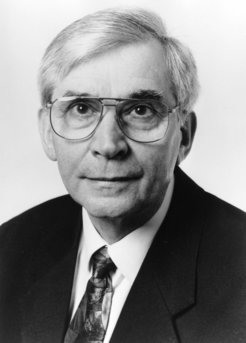
(AMPG Abt., VI, Rep. 1, Johannes Heydenreich no. 1)
Johannes Heydenreich (1930-2015) managed the International Centre for Electron Microscopy founded at the Institute of Solid-State Physics and Electron Microscopy (IFE) of the Academy of Sciences of the German Democratic Republic from 1975 onwards. The IFE was closed after reunification. Subsequently, Heydenreich was appointed one of the Founding Directors of the Max Planck Institute of Microstructure Physics in Halle in 1992. The Institute was the first Institute founded by the MPG in the new federal states. Heydenreich went into retirement in 1996.
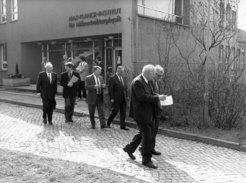
His personal papers include documents of both the IFE and the MPI. From the perspective of history of science, the documents of the transition period are particularly interesting as they provide an insight into the framework conditions of science during a phase of political change.
Size: The collection extends over three running metres; the overall duration covers the years from approx. 1964 until 2003.
Ernst Rabel (AMPG, III. Abt., Rep. 116)
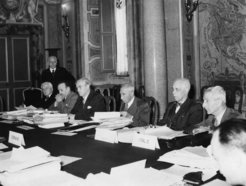
(AMPG, Abt., VI, Rep. 1 Ernst Rabel no. 1)
The acquisition of the personal papers of Ernst Rabel (1874-1955) had been aimed at for a long time. This collection of papers is indeed not very extensive but very prominent, and dates back to the Founding Director of the Kaiser Wilhelm Institute for Foreign and International Private Law. Accession to these personal papers may be deemed extraordinary: The documents compiled from various provenances had been locked up in Ernst Rabel’s overseas trunk at the Max Planck Institute for Comparative and International Private Law in Hamburg for several years before they reached the Archives of the MPG in Berlin after quite lengthy negotiations. Upon its description, the collection of personal papers was digitalized in cooperation with the Hamburg Institute in 2016.
Ernst Rabel’s personal papers have been enriched with documents about his family.
Size: The collection extends over one running metre; the overall duration covers the years from approx.1844 until 1986.
Literature: Rolf-Ulrich Kunze, Ernst Rabel and the Kaiser Wilhelm Institute for Foreign and International Private Law1926-1945 (Geschichte der Kaiser-Wilhelm-Gesellschaft im Nationalsozialismus 9 [History of the Kaiser Wilhelm Society in the National Socialist Era 9]), Göttingen 2008; Ernst Rabel (1874-1955). Texts from the personal papers "Vorträge - Unprinted Lectures", Introduction and publication by Jürgen D. Thieme, in: Rabels Zeitschrift für ausländisches und internationales Privatrecht [Rabels magazine for foreign and international private law] 50 (1986)
Related collections: Department I, Rep. 37, KWI for Foreign and International Private Law; Department III, ZA 130, personal papers of Konrad Zweigert; Department III, ZA 129, personal papers of Hans Dölle
Ernst Schiebold (AMPG, III. Abt., Rep. 79)
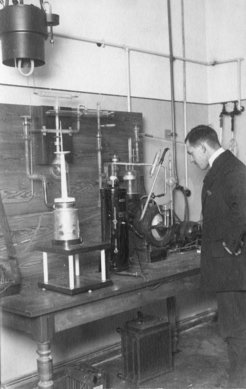
(AMPG, Abt., VI, Rep. 1, Ernst Schiebold no. 6)
The mineralogist Ernst Schiebold (1894-1963) became known by his pioneering achievements in the field of materials investigation by X-rays. In 1922, Schiebold joined the Department for Applied Physics of the Kaiser Wilhelm Institute of Physics in Berlin and applied X-rays as a new method for the study of metals. It was all about the interactions of crystals in the grain structure, which resulted in findings for the industrial application of the materials.
In 1926, Schiebold became a scheduled extraordinary professor for physical-chemical mineralogy, petrography and microstructure at the University of Leipzig; in 1928, he took over the management of the university’s Institute of Mineralogy. Schiebolds research was of great importance for welding technology in bridge and container construction. In 1941, the Technical College of Dresden [TH Dresden] appointed him Director of the recently founded Experimental and Materials Testing Office.
In 1946, Schiebold became chief advisor of the scientific-technical department of the Ministry for Construction Machinery of the USSR, performing structural investigations, among others, in order to determine asbestos substitute materials. In 1951, Schiebold took over the Management of the German Office for Goods and Materials Testing [Deutsches Amt für Material- und Warenprüfung] in Leipzig and from then on dedicated himself to the non-destructive testing of materials. In 1954, Schiebold became professor for materials science and testing at the newly founded University for the Construction of Heavy Machinery [Hochschule für Schwermaschinenbau] in Madgeburg, where he could set up an Institute entirely according to his own ideas. There, he dealt with X-ray macrostructure investigations, voltage measurements, ultrasound materials testing and magnetic procedures.
Size: The collection extends over one running metre; the overall duration covers the years from 1913 until 1964 (with enrichments until 1999).
Reinhold von Sengbusch (AMPG, III. Abt., Rep. 42)
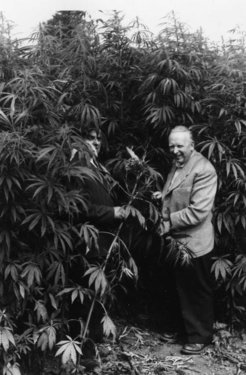
(AMPG, Abt., III, Rep. 42, no. 72)
The botanist and plant breeder Reinhold von Sengbusch (1898-1985) was attached to the Kaiser Wilhelm and the Max Planck Societies for more than 40 years of his scientific career. From 1927 until 1937, Sengbusch worked as an assistant at the Kaiser Wilhelm Institute for Breeding Research; in 1949, he was appointed Scientific Member of the Max Planck Institute for Breeding Research, where he held the position of Director of the Department for Crop Plant Cultivation until 1957 (until 1951 v. Sengbusch Research Unit in the Max Planck Society). In 1957, he was reappointed Scientific Member and Director of the Max Planck Institute for Crop Plant Research (until 1968).
Sengbusch is one of the most important botanists and plant breeders of the 20th century. In the years from 1927 and 1929, he succeeded in selecting individual plants with a low alkaloid content or free of alkaloids among the most important lupin species for agriculture, using a self-developed rapid determination method. In the course of his scientific activity, Sengbusch bred 49 varieties of 11 different crop species, among which the famous strawberry variety Senga Sengana. Another prime example is his breeding of the monoecious hemp variety Fibrimon.
Size: The collection extends over three running metres; the overall duration covers the years from approx. 1927 until 1976.
Literature: Hans Stubbe: Reinhold von Sengbusch zum 60. Geburtstag am 16. 2. 1958 [Reinhold von Sengbusch on the occasion of his 60th birthday on 16 February 1958], in: Der Züchter [The breeder] 28 (1958), pages 1-3; Rainer Reimann-Philipp: Reinhold von Sengbusch 16.2.1898 - 13.6.1985, in: Max-Planck-Gesellschaft. Berichte und Mitteilungen [Max Planck Society. Reports and Communications], Issue 5, 1986, pages 101-103; cf. 1928-2003. 75 Jahre Institut für Züchtungsforschung. Festschrift [75th Anniversary of the Institute for Breeding Research. Commemorative publication], published by the Max Planck Institute for Breeding Research, Cologne 2003.
Related collections: Department I, Rep. 51, KWI for Breeding Research; Department II, Rep. 7, v. Sengbusch Research Unit in the KWG/MPG, Department III, Rep. 4 A and 4 B, personal papers of Erwin Baur.
Hans F. Zacher (AMPG, III. Abt., Rep. 134)
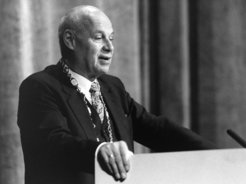
(AMPG, Abt., VI, Rep. 1, Hans F. Zacher no. 4)
After holding various positions in Bamberg, Erlangen and Munich, Hans F. Zacher (1928-2015) was appointed Professor for Constitutional, Administrative and Canon Law to the University of the Saarland in 1963. In 1971, he accepted the appointment of the Law Faculty of the Ludwig Maximilian University of Munich, where he taught public law. In 1980, he became a Scientific Member of the Max Planck Institute for Social Law and Social Policy in Munich.
Zacher is considered to be the founder of social law as a scientific discipline in Germany. As President of the Max Planck Society from 1990 until 1996, his name is inextricably linked with the development of the Max Planck Institutes in the East German federal states.
Zacher’s personal papers encompass his extensive scientific activity; the documents of his presidency are allocated to the relevant archival collection.
Size: The collection extends over 30 running metres; the overall duration covers the years from approx. 1954 until 2016.
Literature: Ulrich Becker, Hans F. Zacher und die rechtliche Ordnung des Sozialen [Hans F. Zacher and the legal order of social affairs, in: Jahrbuch des öffentlichen Rechts der Gegenwart [Yearbook of public law at the present time] 64 (2016), pages 663-671; Michael Stolleis, Hans F. Zacher und die Begründung des Sozialrechts [Hans F. Zacher and the foundation of social law], in: ibid., pages 673-677
Related collections: II. Abt., Rep. 57, President/Presidential Office
Wolfhart Zimmermann (AMPG, III. Abt., Rep. 128)
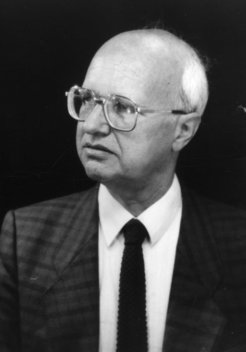
The theoretical physicist Wolfhart Zimmermann (1928-2016) became known as one of the pioneers of the mathematical quantum field therapy in the fifties when he was developing the “LSZ theory” jointly with Kurt Symanzik and Harry Lehmann at the Max Planck Institute for Physics in Göttingen. From 1974 onwards, he had been a Scientific Member and from 1991 until 1996 he was Director at the Max Planck Institute for Physics and Astrophysics in Munich. Apart from that, he had worked as a Honorary Professor at the Technical University of Munich since 1977 and completed various guest stays in Princeton, New York and Paris.
Neben seiner Arbeit am LSZ-Formalismus wurde Zimmermann (zusammen mit Klaus Hepp) für die Entwicklung des Bogoljubow-Parasiuk-Renormierungsschemas bekannt. Auch mit Kenneth Wilson (Operatorproduktentwicklung) und Reinhard Oehme (Reduktion von Kopplungsparametern mit Renormierungsgruppenmethoden) verband Zimmermann eine enge Forschungstätigkeit.
Besides his work on LSZ formalism, Zimmermann (jointly with Klaus Hepp) became known for the development of the Bogoljubow-Parasiuk renormalization scheme. In addition, Zimmermann had close links with Kenneth Wilson (operator product development) and Reinhard Oehme (reduction of coupling parameters with group renormalization methods) through his research activity.
One of the focal points of his personal papers is his correspondence with Hans Joos, Harry Lehmann, Reinhard Oehme, Raymond Stora and Kurt Symanzik, respectively. The collection also includes correspondence with Werner Heisenberg and Wolfgang Pauli.
Size: The collection extends over 1.5 running metres; the overall duration covers the years from approx. 1951 until 2005.
Literature: Peter Breitenlohner (publisher), Quantum Field Theory- Proceedings on the Ringberg Workshop, Tegernsee 1998, On the Occasion of Wolfhart Zimmermann´s 70. Birthday (Lecture Notes in Physics 558), Berlin 2000.
Related collections: II. Abt., Rep. 26, MPI for Physics and Astrophysics; Department III, Rep. 93, personal papers of Werner Heisenberg; Department III, Rep. 107, personal papers of Julius Wess








